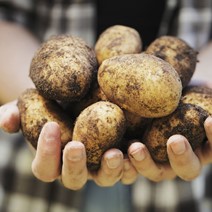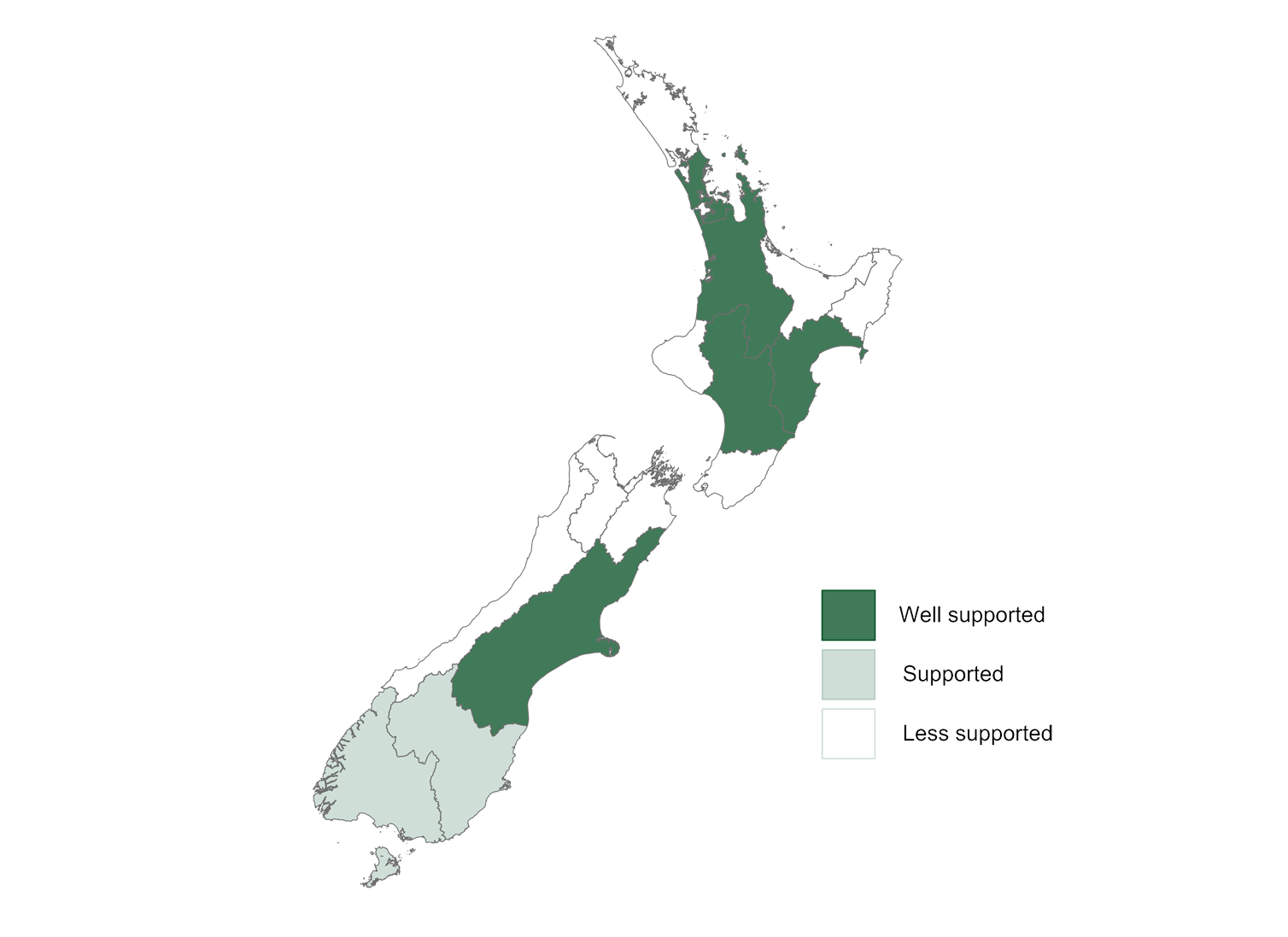
Land use fact sheet
Potatoes
New Zealand uses more land for growing potatoes than any other crop, with over 10,000 hectares grown by 175 commercial potato growers each year. The industry has shown steady growth over the years – in 2018 the national crop increased by 30,000 tonne to over half a million tonnes in total, and generated over a billion dollars in revenue.
Industry body Potatoes New Zealand offers a wide range of support for members including information, advice, and grants for work that explores or develops new markets.
Potato crops have the same basic growing requirements as a wide range of other fresh vegetable crops, so they're a great option to include in your rotation.
 Overview
Overview
Regions
Most of New Zealand's potatoes are grown in Canterbury, Auckland, Waikato, Manawatu-Wanganui and Hawke's Bay.
Growing conditions
Potatoes need fertile, well drained soils with good sun. Land should be flat or gently rolling, so machinery can operate.
Climate
Potatoes grow best between 18oC and 20oC. They don’t grow well in temperatures below 10oC or above 30oC.
Commercial scale
Less than 5 hectares may be unprofitable. Bigger tends to be better, with larger blocks giving better profits.
Getting started
You can grow under contract with a processor, sell directly to a wholesaler or lease your land to another grower.
Skills / employment
You’ll need to understand the technical processes of preparing, planting and monitoring the crop as it grows.
 Regions
Regions
Potatoes are a versatile crop that can be found growing across the main regions of New Zealand. The largest producer is Canterbury, followed by Auckland, Waikato, Manawatu-Wanganui and Hawke's Bay.
Potatoes can also be found found growing commercially in Otago and Southland.
Get a report on your whenua
Enter the details of your whenua into our search to create a downloadable report showing information about the environment, economy, and climate in your region — and the potential that creates for development.

 Commercial scale
Commercial scale
Commercially viable blocks start around 5 hectares. Larger blocks have lower per hectare costs and other benefits of scale, so more land will provide better results. You will need access to considerably more land if you are purchasing machinery and developing a packhouse.
 Getting into the industry
Getting into the industry
Potatoes are efficient, adaptable and high yielding. More than 50 varieties are grown in New Zealand. Growers choose their varieties based on location, and whether they're growing:
- table or fresh potatoes
- for processing, or
- for seed.
Potatoes should be rotated with other crops to manage disease and support soil health — it's best not to grow them in the same field 2 seasons in a row.
The 3 main avenues into the potato industry are:
- leasing your land to a grower
- contracting with a processor, or
- selling on the open market.
Many growers also sell some of their crop to people at local markets and from roadside stalls. Growers get a higher price, but it is not usually possible to sell your whole crop this way.
Potatoes New Zealand can give you advice when you are working out the best option for your whenua.
Leasing
Established growers are often eager to lease land that they can work into their existing crop rotation. The market rate for land that can support potato production can be up to $2,200 to $3,000 per hectare. The rate is decided by factors like location, soil, and the condition of the land.
The landowner would usually charge the lessee for the use of water, if irrigation is provided.
The lease contract will include information about:
- how long the lessee can use your land
- what they're allowed to use it for, and
- how they must maintain facilities and look after the land.
It's important to get advice from qualified, experienced advisors before you commit to leasing your whenua.
Contracting to a processor
A contract is an agreement with a processor such as Watties, Mr Chips or McCain foods. The contract is signed before you plant your crop. It will tell you:
- what variety to plant
- when it needs to be harvested
- how much you will be paid per tonne
Your contract may include conditions about the quality of the crop and how much the processor will take.
Open market
The open market means selling to a wholesaler, such as Turners and Growers or MG Marketing, who on-sells to supermarkets, shops and other retailers.
Wholesalers do not usually offer supply contracts. They will purchase the product:
- when it is available, and
- for a price that is set by market conditions at that time.
It is still important to get in touch with the wholesaler before you plant, to confirm that they will take your crop when it’s ready.
Equipment and infrastructure
Whether contracting or supplying the open market, you’ll need access to potato planting and harvesting equipment. You may be able to hire the equipment in your area, but if not it can be expensive to buy. For example:
- a potato planter costs around $45,000, and
- a potato harvester costs between $170,000 and $210,000.
 Skills and employment
Skills and employment
The grower needs to understand the technical processes of preparing, planting and monitoring the crop as it grows. This is likely to include:
- handling dangerous substances, including sprays and fertilisers
- operating equipment, including tractors and specialised heavy machinery
- understanding compliance obligations, including nutrient management, the Food Act and New Zealand Good Agricultural Practice (NZGAP).
If you're considering growing potatoes for first time, contact Potatoes New Zealand to find out about the support they offer to growers.
 Compliance
Compliance
As with any business, there are compliance regulations for health, safety and wellbeing, employment law and tax obligations. Some of the key industry-specific compliance obligations are listed below.
Levies
Growers are supported by Horticulture New Zealand and Potatoes New Zealand. Both organisations collect compulsory levies under the Commodity Levies Act 1990.
- Potatoes New Zealand collects $0.85 per $100 of sales, and
- Horticulture New Zealand collects $0.14 per $100 of sales.
These levies can change, so check their websites to make sure you have the latest information.
Horticulture New Zealand membership levy
Potatoes New Zealand grower levy
Food safety
All growers must meet the requirements of National Programme 1 under the Food Act 2014. The requirements include rules about how the crop is handled, managing spray residue, and withholding periods. This to make sure the potatoes you’re supplying to the market are safe to eat.
New Zealand Good Agricultural Practice (NZGAP)
NZGAP is a system that helps growers to keep up with compliance requirements, including food safety requirements. Some retailers and wholesalers will only take crops from an NZGAP certified supply channel. Becoming NZGAP certified:
- gives you confidence that you're meeting compliance requirements
- makes it easier to find out when regulations have changed, and
- ensures your product meets buyer requirements.
Some wholesalers hold NZGAP certification on behalf of the grower. Check with the company that you are supplying.
More information about NZGAP is available from their website.
Council regulations
Many councils require consents for access to irrigation water and for other activities related to changing land use.
Speak to your local council before investing in any detailed planning or development work to ensure you are aware of any consents or permits needed to start growing potatoes on your whenua.
Meeting council compliance obligations
National policy statement for freshwater management (NPSFM)
The National Policy Statement for Freshwater 2020 gives local authorities direction on how they should manage freshwater under the Resource Management Act 1991. As such, some local authorities require growers and farmers to create a Farm Environment Plan (FEP). Make sure you're familiar with the FEP expectations in your region. Check with your local council about the requirements for your whenua or planned development.
Even if your region doesn't yet require an FEP, it's good practice to put one in place for your whenua as part of your business plan. The Foundation for Arable Research (FAR) provides templates you can use to create an FEP.
 Growing conditions
Growing conditions
Like most vegetable crops, potatoes are best suited to flat to rolling land and LUC classes 1-4. They love soils that are deep, easily worked, and well drained. Sandy soils are more likely to need irrigation than other soil types.
Potatoes prefer a sunny aspect. Yield will suffer if they’re shaded during the day. They can happily grow in windy conditions — in fact, good airflow through the leafy canopy helps manage some pests and diseases.
Potatoes are susceptible to many different pests and diseases. Crop rotation is one of the most important and effective pest control methods. Potatoes should be alternated with at least one other crop for up to 5 years. Best practice is to then rest the field in pasture for 3-5 years before cropping again.
Potatoes have one of the highest levels of nitrogen leaching among common vegetable crops. This can be reduced by crop rotation — for example, by growing a crop such as brassicas in the year before and the year after your potato crop, to reduce the amount of nitrogen in the soil. It’s also important to test your soil before adding any fertiliser, to make sure you don't add any more than the crop needs.
Certified nutrient management advisors can help you manage nutrient levels and leaching in your soils.
Planting
Potatoes are planted in late winter to late spring, depending on:
- soil temperature
- weather conditions
- the variety being sown, and
- any contracted agreement for harvest dates.
Talk to your seed merchant for planting advice that suits your land block and the variety you’re planting.
Crops are grown from seed potatoes dropped into furrows by a mechanical planter at a precise depth and spacing. The soil is then ridged to form rows over the seeds.
Potatoes are susceptible to insect, viral, bacterial and fungal diseases. Use certified or pathogen tested seed to make sure your crop starts out healthy, and don’t grow potatoes in the same place 2 years in a row.
Growing season
Potatoes grow for 120-150 days from the date of planting. Weeds and insect pests are controlled while the crop is growing using a mixture of cultivation methods and sprays.
Harvest
The crop will usually be ready to harvest 120-150 days after planting, depending on the variety planted and growing conditions. Potatoes don't have to be harvested right away unless you have a contract that specifies a harvest date. Like carrots, they can be stored in the ground for weeks or months. You can wait until weather conditions, availability of contractors and market conditions are suitable before harvesting your crop.
Potatoes don't need to be cured or stored after harvest. Fresh potatoes can be on retail shelves within hours of coming out of the ground.
 Climate
Climate
The best yields are achieved when the average daily temperature is between 18oC and 20oC — potatoes don’t grow well in temperatures below 10oC or above 30oC.
You’ll need to plant the crop after the risk of frost has passed, as frost will damage the plants.
 Water
Water
Potatoes have shallow roots and they're sensitive to drought. Lack of water when tubers are developing will give you a lower yield, with heavier cropping varieties showing the biggest loss.
A typical 120-150 day potato crop will use 500-700mm of water over the growth period. Monitor the water content of the soil and weigh up the cost of irrigation against the potential loss of yield if the soil begins to dry out.
Potatoes will happily grow in areas that may be too damp for other crops. This may mean extra costs in other areas, such as:
- boggy conditions during harvest
- more fuel cost to drag heavy, mud-clogged bins, and
- more time and money spent on cleaning the crop for the market.
 Market
Market
Potatoes are grown to be sold either as seed, fresh for the table, or to be processed into potato chips and frozen chips. Currently, the value generated by potatoes in NZ is:
- 55% from process crops
- 24% from fresh use
- 19% from crisps, and
- 2% from seed production.
Each of these market sectors have domestic and export markets. Around 25% of our total crop is exported. Our strongest export market is in frozen chips, thanks to the presence of several major local processing companies.
 Future industry
Future industry
The 3 key strategic targets for the industry are:
- to increase profit per hectare by $150 year on year, by improving productivity
- to double the value of all exports by 2025
- to increase the value of the domestic market by 50% by 2025.
Soil, water and environment are key themes in the strategic plan, with a focus on developing infrastructure and methods to improve the efficiency of water and nutrient use.
 Operational costs
Operational costs
Operational costs for a season of growing potatoes depends on the variety you’re growing, and whether you own your own machinery or are using contractors.
Spraying, fertilising and cultivating the land is typically around $2,200 per hectare. Seed potatoes average around $2,500 per hectare, and the average cost for hiring a contractor to plant is around $150 per hectare. This means there’s a total cost of around $5,000 per hectare to establish and grow the crop.
The cost of harvest depends on whether or not you’ll be hiring contractors to provide the harvester, and the arrangement you have in place for packing. If you’re using a local packhouse, get in touch with them to discuss costs.
 Grower returns
Grower returns
The income from your crop is determined by your yield and the price you’re paid per tonne.
The yield depends on the variety grown and the growing conditions during the season. The average crop size has increased steadily over the last 20 years and now sits at an average of 64 tonne per hectare.
There are more than 50 varieties of potato grown commercially in New Zealand, so talk to your seed merchant about the best varieties for your region and the yield you should reasonably expect.
The price you’re paid for your crop is either set down in your contract (if you have a contract with a processor), or set by the market at the time you harvest your crop. In the 3 years to 2017 the average price for open market potatoes varied between $400 and $700 per tonne, depending on:
- the varieties available
- the quantity coming to the market, and
- demand from consumers.
There’s a slight premium for early season potatoes, with at least $500-$600 per tonne expected.
Potatoes store well in the ground, so you have some flexibility on when to bring the crop to market if you miss the early season. Base your harvest date on the availability of equipment and labour, as well as discussions with your wholesaler about what the market’s doing.
Based on an average yield of 64 tonne and a market price of $400-$700 per tonne, the average gross revenue per hectare is in the range of $25,600 to $44,800.
 Seek advice
Seek advice
Seek advice early, before you invest in any design or development.
Talk to your local Te Puni Kōkiri office to see how they can support you through your decision-making process. They will be able to provide advice and find out whether your project qualifies for funding.
Talk to the industry organisation to see what support and resources they can offer to people thinking about growing potatoes.
If possible, seek out advice from people who grow potatoes in your area as well as knowledgeable suppliers.
Talk to qualified consultants who are experienced in potato growing and other land developments in your area. They will be able to provide detailed, impartial advice on what will (and won't) work on your whenua.
 About this fact sheet
About this fact sheet
This fact sheet provides general information to help start and inform conversations. It is not comprehensive enough to support detailed decision-making.
The information in this fact sheet has been contributed by AgFirst, Fresh Facts, Potatoes New Zealand and Te Puni Kōkiri kaimahi. Data that has not been credited in the body of the fact sheet has been sourced from StatsNZ or provided by the contributors.
You can provide feedback on the content on this or any fact sheet by emailing the Whenua Māori Service at whenuainfo@tpk.govt.nz